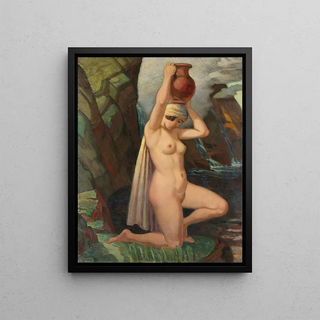Art print | The Water Carrier - Ludwig von Hofmann


View from behind

Frame (optional)
In the vast panorama of art history, certain artworks manage to capture the very essence of beauty and visual poetry. "The Water Carrier" by Ludwig von Hofmann is one of those iconic creations that transcend time and space. This piece, imbued with delicacy and sensitivity, evokes an atmosphere of serenity while highlighting the harmonious relationship between man and nature. Through subtle nuances and refined compositions, Hofmann invites us to contemplate a suspended moment, where the water carrier becomes both a symbol of everyday life and an almost mythical figure, embodying the quiet strength of existence.
Style and uniqueness of the artwork
Ludwig von Hofmann's style is characterized by a unique fusion of Impressionism and symbolism, creating an aesthetic that is entirely his own. In "The Water Carrier," shimmering colors and fluid shapes blend to bring to life a vibrant and poetic scene. Light plays a predominant role, illuminating the face of the carrier and the reflections of the water, while soft shadows add depth to the composition. The way Hofmann uses color and texture allows us to almost physically feel the warmth of the sun and the coolness of the water. Each brushstroke seems charged with emotion, transforming a simple scene into a work of art that speaks to the soul. The delicacy of the features and the finesse of the details testify to an exceptional craftsmanship, making this piece a true masterpiece of modern painting.
The artist and his influence
Ludwig von Hofmann, born in 1861, is a significant figure in the German artistic movement at the end of the 19th century and the beginning of the 20th century. His artistic journey is marked by encounters and influences that shaped his style. Studying at the Academy of Fine Arts in Munich, he was exposed to innovative ideas from his contemporaries, while absorbing artistic traditions from earlier periods. His work is often characterized by an exploration of themes such as nature, mythology, and sensuality, which earned him

Matte finish

View from behind

Frame (optional)
In the vast panorama of art history, certain artworks manage to capture the very essence of beauty and visual poetry. "The Water Carrier" by Ludwig von Hofmann is one of those iconic creations that transcend time and space. This piece, imbued with delicacy and sensitivity, evokes an atmosphere of serenity while highlighting the harmonious relationship between man and nature. Through subtle nuances and refined compositions, Hofmann invites us to contemplate a suspended moment, where the water carrier becomes both a symbol of everyday life and an almost mythical figure, embodying the quiet strength of existence.
Style and uniqueness of the artwork
Ludwig von Hofmann's style is characterized by a unique fusion of Impressionism and symbolism, creating an aesthetic that is entirely his own. In "The Water Carrier," shimmering colors and fluid shapes blend to bring to life a vibrant and poetic scene. Light plays a predominant role, illuminating the face of the carrier and the reflections of the water, while soft shadows add depth to the composition. The way Hofmann uses color and texture allows us to almost physically feel the warmth of the sun and the coolness of the water. Each brushstroke seems charged with emotion, transforming a simple scene into a work of art that speaks to the soul. The delicacy of the features and the finesse of the details testify to an exceptional craftsmanship, making this piece a true masterpiece of modern painting.
The artist and his influence
Ludwig von Hofmann, born in 1861, is a significant figure in the German artistic movement at the end of the 19th century and the beginning of the 20th century. His artistic journey is marked by encounters and influences that shaped his style. Studying at the Academy of Fine Arts in Munich, he was exposed to innovative ideas from his contemporaries, while absorbing artistic traditions from earlier periods. His work is often characterized by an exploration of themes such as nature, mythology, and sensuality, which earned him






